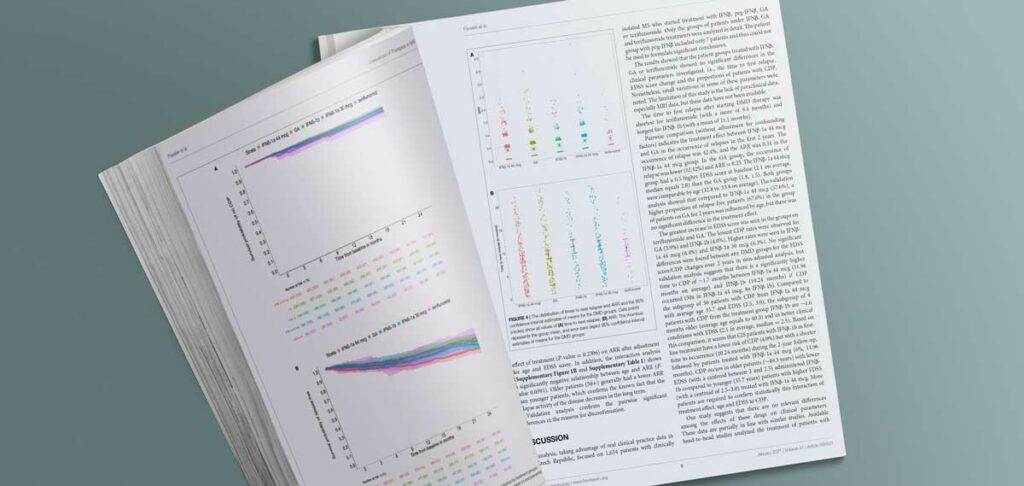Multiple sclerosis (MS) is a chronic inflammatory and neurodegenerative disease of the central nervous system. After the first demyelinating episode, well-established drugs such as glatiramer acetate (GA), interferon beta-1a (IFNβ-1a), IFN beta-1b (IFNβ-1b), peginterferon beta-1a (peg-IFNβ-1a) and teriflunomide are commonly used in MS patients. The aim of this observational study was to compare the efficacy of these drugs in MS patients who started treatment after a first demyelinating event. The study uses data from the national ReMuS registry and includes follow-up of patients for up to two years in real clinical practice in the Czech Republic. The results of the study provide valuable information for clinical practice and treatment selection based on individual risks and patient preferences.

Pavelek, Z., Sobíšek, L., Šarláková, J., Potužník, P., Peterka, M., Štětkárová, I., Štourač, P., Mareš, J., Hradílek, P., Ampapa, R., Grünermelová, M., Vachová, M., Recmanová, E., Angelucci, F., Halúsková, S., & Vališ, M. (2021). Comparison of Therapies in MS Patients After the First Demyelinating Event in Real Clinical Practice in the Czech Republic: Data From the National Registry ReMuS. In Frontiers in Neurology (Vol. 11). Frontiers Media SA. https://doi.org/10.3389/fneur.2020.593527 PMID: 33510704
Abstract
Introduction: Multiple sclerosis (MS) is a chronic inflammatory and neurodegenerative disease of the central nervous system. In the Czech Republic, well-established drugs including glatiramer acetate (GA), interferon beta-1a (IFNβ-1a), IFN beta-1b (IFNβ-1b), peginterferon beta-1a (peg-IFNβ-1a) and teriflunomide are commonly used in MS patients after a first demyelinating episode.
Target: The aim of this observational study was to compare the efficacy of the aforementioned drugs in MS patients who started their treatment after a first demyelinating event. Patients were followed for up to 2 years in real clinical practice in the Czech Republic.
Methods: A total of 1,654 MS patients who were treated after a first demyelinating event were enrolled in the study and followed up for 2 years. Parameters assessed (endpoints) included annual relapse rate (ARR), time to next relapse, change in Expanded Disability Status Scale (EDSS) score, and time to confirmed disease progression (CDP). If patients discontinued treatment before the end of the follow-up period, reasons for discontinuation were compared across therapies.
Results: No significant difference was found between the groups of patients treated with IFNβ-1a/1b, GA or teriflunomide in the following parameters: time to first relapse, change in EDSS score and proportion of patients with CDP. A significant increase in the percentage of patients without relapse was found with GA compared to IFNβ-1a (44 mcg), but this treatment effect was not confirmed by validation analysis. There was a significant difference in reasons for treatment discontinuation in GA compared with other drugs.
Conclusion: There were small differences between GA, IFNβ and teriflunomide therapies that did not have a significant impact on the final outcome at 2 years. Therefore, in clinical practice, we recommend choosing treatment based on individual potential risk from long-term therapy and on the basis of patient preferences and clinical characteristics.
You can read the full article in English on the magazine's website Frontiers in Neurology.

